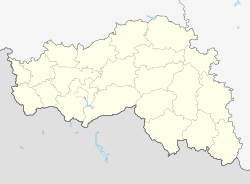Alexejewka (Belgorod)
| city
Alexejewka
Алексеевка
|
||||||||||||||||||||||||||||||||||||||||||
|
||||||||||||||||||||||||||||||||||||||||||
|
||||||||||||||||||||||||||||||||||||||||||
| List of cities in Russia | ||||||||||||||||||||||||||||||||||||||||||
Alexejewka ( Russian Алексе́евка ) is a town in Belgorod Oblast ( Russia ) with 39,026 inhabitants (as of October 14, 2010).
geography
The city is located on the southern edge of the Central Russian Plate, about 300 km east of the Oblast capital Belgorod on the Tichaya Sosna , a right tributary of the Don .
Alexejewka is administratively directly subordinate to the Oblast and at the same time the administrative center of the Rajon of the same name .
history
Alexejewka was established in 1685 (according to other sources, 1691) as a craft and trading settlement ( Sloboda ). An alternative name at this time was Alexejewskaja (Sloboda) . It was probably named after the first owner Alexei Cherkassky (1680–1742).
The place experienced an economic boom with the opening of the first oil mill in 1833 with the help of the serf Daniil Bokarjow from the Tula governorate , who had invented a method for extracting oil from sunflower seeds in 1829 (see also city arms). It was the first oil mill of its kind in Russia; Bokarev himself opened another in Alexejewka in 1834.
By the end of the 19th century, the village , which belonged to the Voronezh governorate until the 1920s, had more inhabitants than many cities. In 1939 Alexejewka received urban-type settlement status .
During the Second World War , Alexejewka was occupied by the German Wehrmacht in July 1942 and recaptured on January 19, 1943 by troops of the Voronezh Front of the Red Army as part of Operation Ostrogoschsk-Rossosh .
The town charter was granted on August 19, 1954.
Population development
| year | Residents |
|---|---|
| 1939 | 9,916 |
| 1959 | 20,148 |
| 1970 | 25,562 |
| 1979 | 31,554 |
| 1989 | 36,641 |
| 2002 | 39,312 |
| 2010 | 39,026 |
Note : census data
Culture and sights
In Alexeyevka are the Holy Trinity Church ( Троицкая церковь / Troitskaya Tserkov) of 1809, the Of Saint Dmitri of Rostov-Church ( церковь Дмитрия Ростовского / Zerkow Dmitrija Rostowskogo) of 1813 and the Alexander Nevsky 's Church ( церковь Александра Невского / Zerkow Alexandra Newskogo) from 1888.
The city has a local museum.
economy
In addition to a number of companies in the food industry (oil, sugar, canned milk, etc.), there are companies in electrical engineering and chemical device construction ( Chimmasch ) and the construction industry.
Alexejewka is located on the railway line Kharkiv - Waluiki - Balaschow - Penza, which was opened on this section in 1895 . The regional road R185 Belgorod - Korotscha - Nowy Oskol - Rossosh runs through the city .
sons and daughters of the town
- Andrei Kirilenko (1906–1990), politician
- Matwei Shaposhnikov (1906-1994), General
Individual evidence
- ↑ a b Itogi Vserossijskoj perepisi naselenija 2010 goda. Tom 1. Čislennostʹ i razmeščenie naselenija (Results of the All-Russian Census 2010. Volume 1. Number and distribution of the population). Tables 5 , pp. 12-209; 11 , pp. 312–979 (download from the website of the Federal Service for State Statistics of the Russian Federation)
Web links
- Rajon and City Administration website (Russian)
- City's unofficial website (Russian)
- Alexejewka on mojgorod.ru (Russian)






